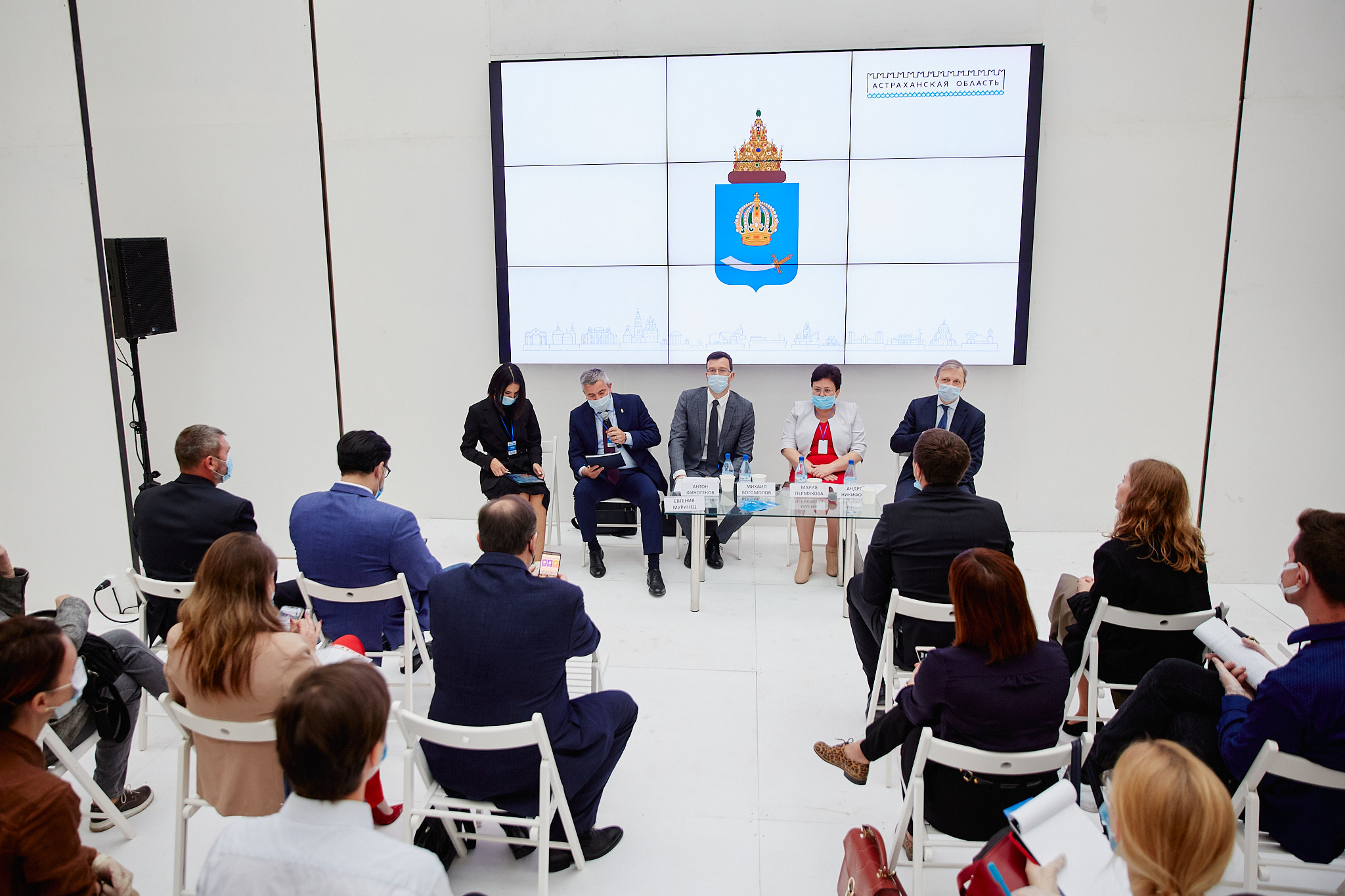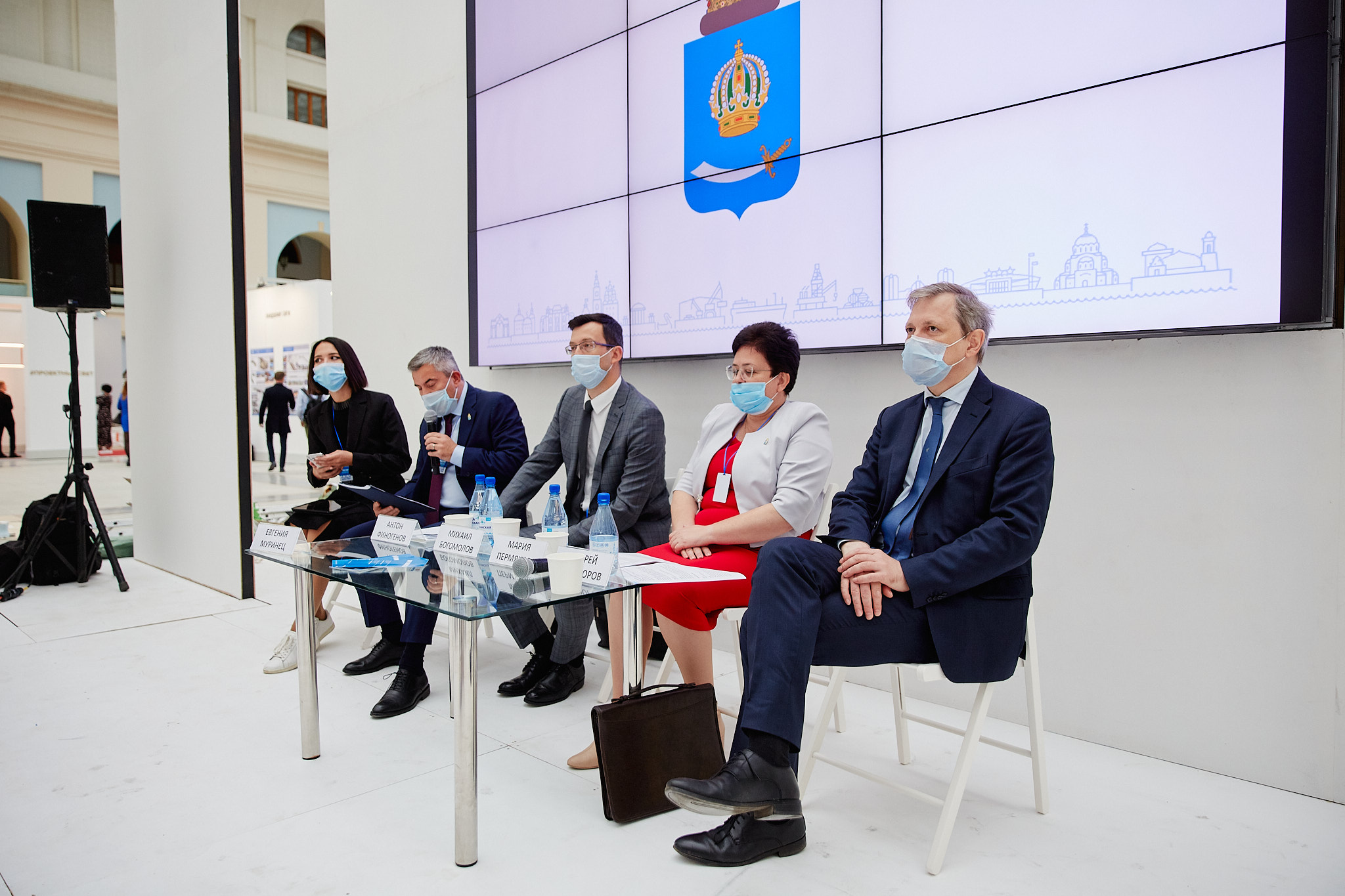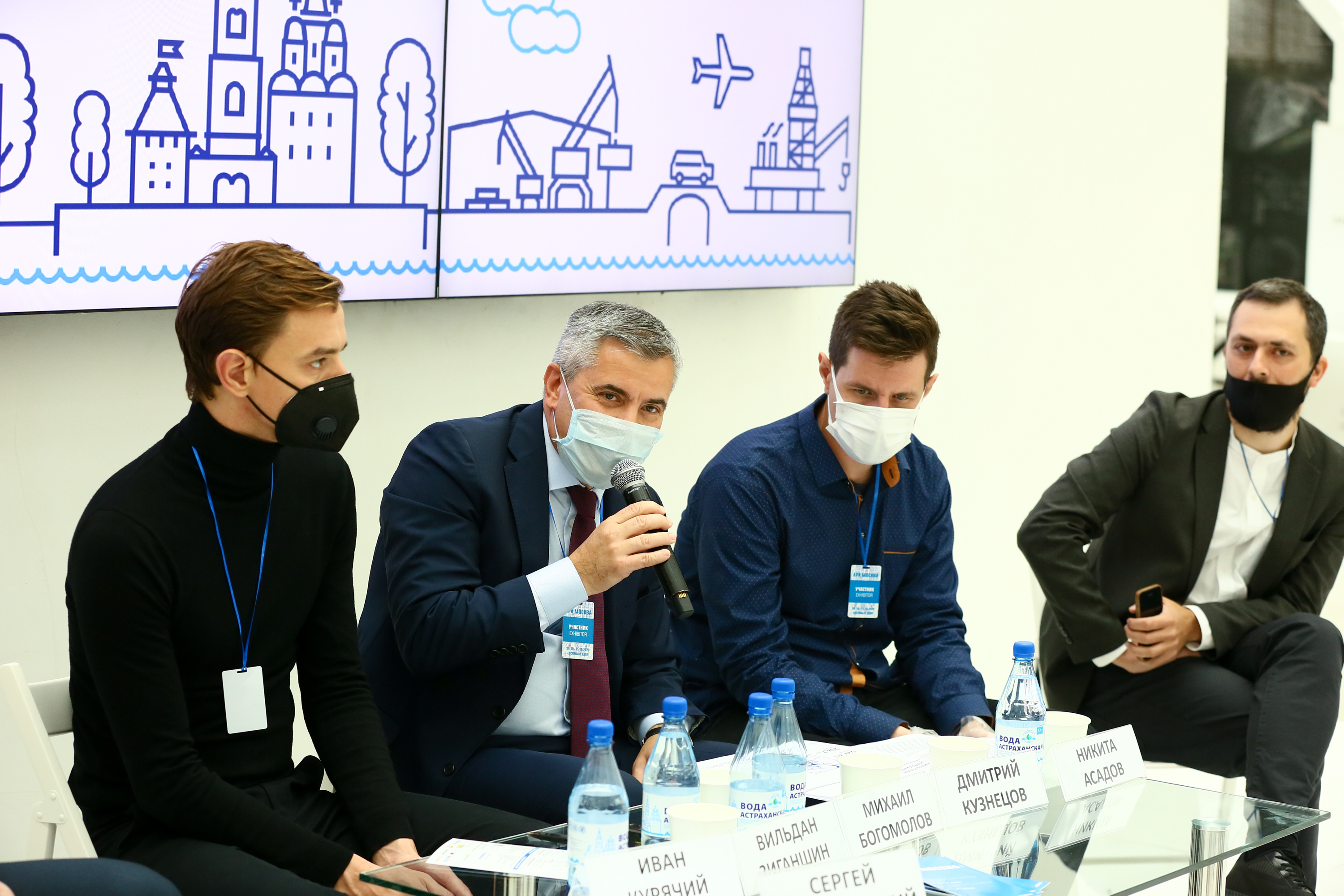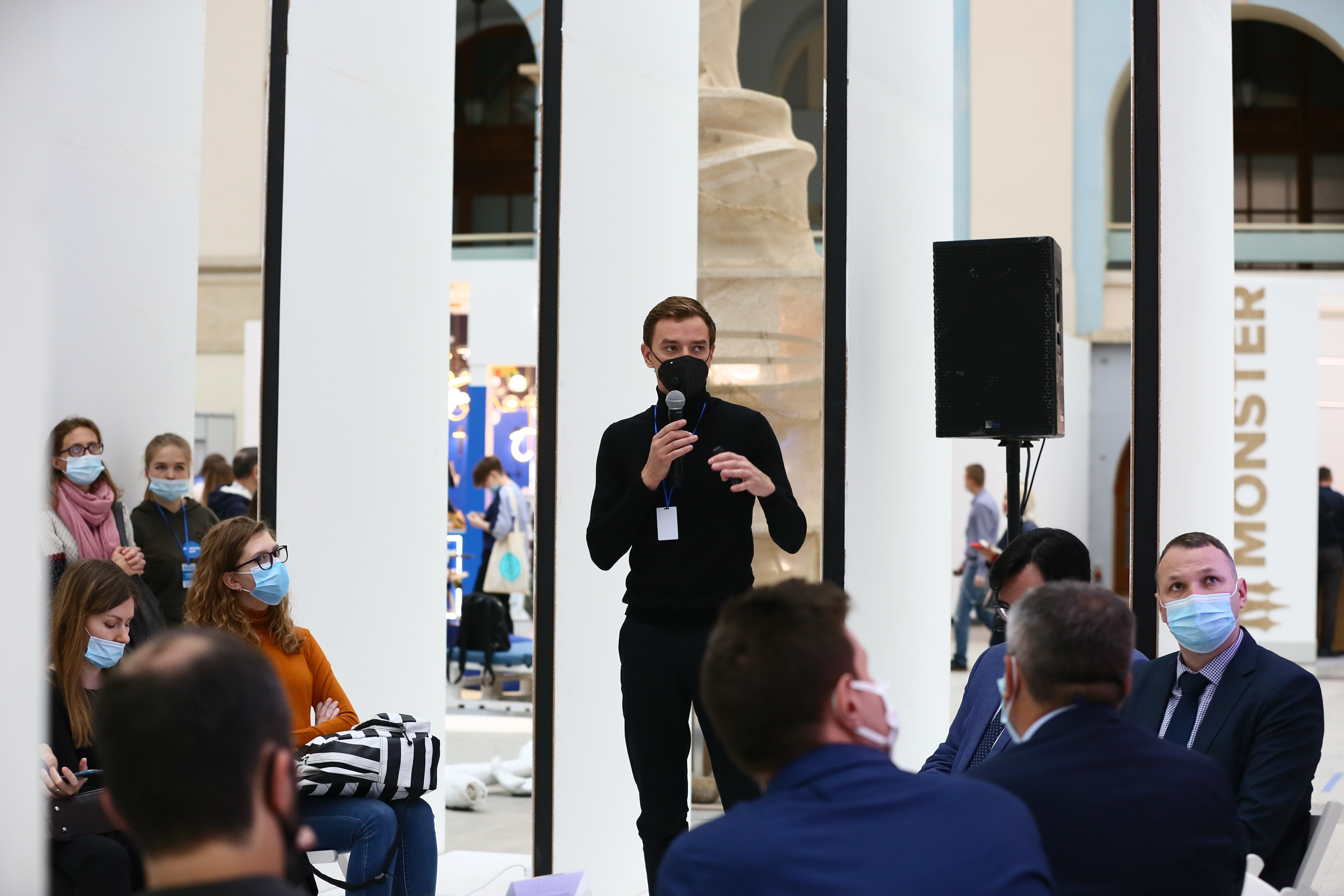ARCHMOSCOW 2020: ASTRAKHAN REGION: THE LAND OF CHANGE
The ARCHMoscow exhibition, one of the most significant events for the Russian architecture community, ended this Sunday. The year 2020 marks an important milestone for the exhibition: its 25th anniversary. Astrakhan Region was a special guest and contributor to the event. Its extensive business program addressed challenges relevant to the region—from master planning and the creation of a comfortable urban environment, to the preservation of cultural heritage and art residencies—in a nationwide context. The operator of the program was the Agency for Strategic Development CENTER.
Between October 8 and 10, the snow-white booth of Astrakhan Region at the ARCHMoscow exhibition, in the very heart of Gostiny Dvor, hosted 6 discussions with more than 30 speakers, from local representatives who shared their region’s issues with guests, to experts with ZOOM presentations. Due to the current health regulations, there were few audience seats, but eager listeners crowded around the booth, and many of the hundreds of people interested in watching the presentations had to stand.
Astrakhan Region is one of Russia’s main hubs for diplomatic and cultural relations with the Caspian region and its eastern neighbors. It is the point where multiple water and overland trade and travel routes intersect and is a melting pot of many ethnicities and religions. The region is home to almost 900 cultural heritage sites, 600 of which are located in the capital, earning it the “historical settlement of federal importance” designation (awarded in 2010). Mindful of its immense historical heritage, the region aims to preserve and increase its human capital and to take its quality of life to a whole new level. The goals set by Astrakhan Region include: the creation of a comprehensive approach to the development of Astrakhan and the Astrakhan Agglomeration, being especially mindful of its rich history and of the land plots where new construction is allowed; the development of tourist infrastructure and the creation of a diverse cultural event program; the formation of a comfortable urban environment for the local community and for visitors to the region; and ensuring the quality of the development of public spaces. These aspects were listed as the key topics on Astrakhan’s business agenda at ARCHMoscow 2020. All of Astrakhan Region’s discussion sessions facilitated the sharing of experience and the development of optimal solutions for a number of regional development issues concerning urban planning, architecture, development, and more. That is why the government representatives were so frank about the local problems and challenges. Together with experts, they went over possible ways out of local crises, identified directions for development, and learned about successful case studies, discussing whether or not they were applicable to Astrakhan Region’s unique situation.



The discussion program was particularly focused on the development of the agglomeration, comprehensive territorial development, and master planning as one of the essential strategic tools for ensuring the efficient development of the city and the Astrakhan Agglomeration in general (for reference: the agglomeration is over 20 thousand square kilometers in size and is home to 635,000 people).
Mikhail Bogomolov, deputy head of the regional administration, explained that the city had already started preparing materials for a master plan and teased an upcoming international competition for the Astrakhan Agglomeration’s master plan, which is to be announced in the very near future. One of the stages of preparing the Astrakhan Agglomeration’s master plan will involve a comprehensive study, wherein experts will analyze the region’s potential for development. There are plans to get both federal experts and the local community actively involved in making major changes in the region. The official believes that the region’s urban development will be improved thanks to the input from the experts that took part in the discussion. Real case studies on the design of master plans for major territories and even cities (as presented by the participants in the creation of the Derbent master plan) have also been vital for understanding the development objectives and finding ways to achieve them.
Every morning at the Astrakhan Region booth began with a talk that brought together regional and federal officials and experts from various fields: distinguished architects, designers, developers, analysts, and representatives of federal agencies. They included: Evgeniya Murinets, director of the Urban Policy Institute and advisor to the Governor of the Astrakhan Region; Andrey Nikiforov, deputy director of the Department of Territorial Development Planning of the Russian Ministry of Economic Development; Anton Finogenov, Deputy General Director of the DOM.RF Foundation; Kristina Shapotko, curator of the Urban Environment Quality Index project run by the Ministry of Construction, Housing and Utilities; Vildan Ziganshin, aide to the Russian Minister of Construction, Housing and Utilities; Mikhail Bogomolov, deputy head of the Astrakhan Region government; Maria Permyakova, mayor of Astrakhan; Ivan Kuryachiy, managing partner of the Novaya Zemlya Company; Nikita Asadov, chief architect and project designer at ASADOV Architects; Olga Prokofyeva, Minister of Culture and Tourism of Astrakhan Region; Ekaterina Cherkes-Zade, director of Universal University and creative industry expert; and others.



Astrakhan Region’s historical heritage also came into the spotlight. The speakers talked extensively about the need for a properly timed effort to preserve the local architectural landmarks, three quarters of which are currently in very poor conditions (84% of the local cultural heritage objects have not been preserved properly). The participants in the session were particularly emphatic about respecting Astrakhan’s current historical environment and safeguarding its architectural and aesthetic value. This gave special weight to the input of the consultants, who shared their successful case studies in cooperation between the business community and regional authorities in the field of revitalizing historical locations. This is particularly relevant to Astrakhan, as its historical center spans 900 ha. This large territory includes not only culture and leisure venues, but also actively developing businesses; furthermore, its antiquated residential facilities require urgent attention (more than 1715 buildings in the city constitute a hazard, and more than 600 are in an unlivable condition). Developers from Astrakhan also offered their successful case studies for discussion, including high-quality apartment blocks and a modern apartment hotel in the city center.
A special session was dedicated to art residencies as unique spaces for accumulating the city’s creative energy. Astrakhan’s administration is interested in the development of the creative economy, especially in cities with similar characteristics, so Tula, Ufa, and Yaroslavl were also welcomed to the discussion. Astrakhan presented a successfully completed project: a modern IT cluster.
Two sessions covered construction in the city, particularly its historical center, as well as the creation of a comfortable, high-quality, and accessible urban environment. Utility issues, particularly the condition of the city’s utility system, were also touched upon. Even though the region has already done a lot to improve its public spaces (288 territories have been renovated since 2017), it has also announced its plans for 2024: developing another several hundred public spaces, from courtyards to parks. The project is to receive more than 1.5 billion rubles in funding. Astrakhan is simultaneously working on several programs that are meant to alter its urban environment, including the Renewed Astrakhan and the Creation of a Comfortable Urban Environment programs. The city’s transport infrastructure, the condition of the local street and road network (including bridges), and the unique challenges faced by a community built around a river were also discussed extensively.
Astrakhan’s presentation at the exhibition included an announcement that the city has been included in the list of comfortable cities. The Urban Environment Quality Index was developed jointly by the Ministry of Construction, Housing and Utilities and the DOM.RF Foundation. According to the Index, a comfortable city is one that scores at least 180 points out of 360. Astrakhan has earned 181 point, so its journey towards a comfortable environment is only just beginning.